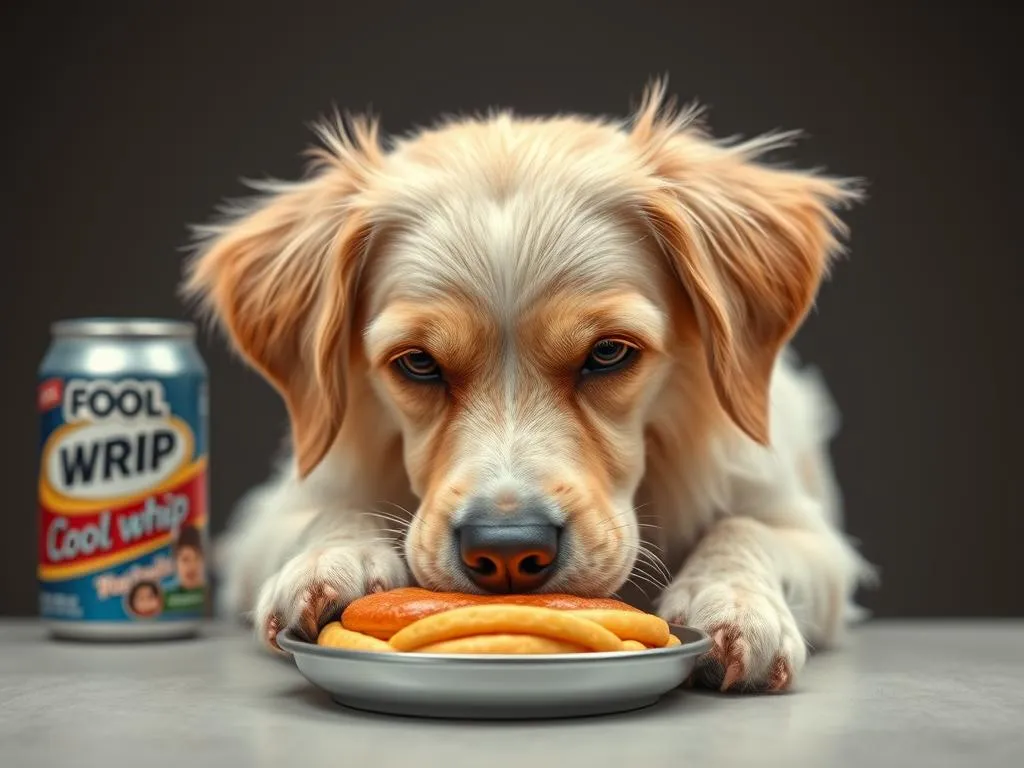
Understanding the nutritional needs of our canine companions is vital for their overall health and well-being. As dog owners, we often find ourselves questioning what human foods are safe for our furry friends. One common query that arises is, can dogs eat Cool Whip? This seemingly innocent question opens up a broader discussion about the safety of various human foods in a dog’s diet and the importance of making informed dietary choices.
Understanding Dog Nutrition
Basics of Dog Nutrition
Dogs have specific nutritional requirements that differ significantly from those of humans. A balanced diet for dogs typically includes proteins, fats, carbohydrates, vitamins, and minerals. Here’s a brief overview of these essential nutrients:
- Proteins: Critical for growth, repair, and maintenance of body tissues. Dogs require high-quality protein sources such as meat, fish, and eggs.
- Fats: Provide energy and are necessary for healthy skin and coat. Healthy fats can come from fish oils and animal fats.
- Carbohydrates: While not essential, they can provide energy and support digestive health. Common sources include grains and vegetables.
- Vitamins and Minerals: Essential for various bodily functions, including immune response and bone health. A varied diet helps ensure dogs receive these nutrients.
Unlike humans, dogs do not require sugars and processed foods in their diet. Their digestive systems are adapted for a carnivorous diet, making it crucial to avoid feeding them human foods that may not be suitable.
The Role of Treats in Dog Diet
Treats play a significant role in a dog’s diet, primarily for training and bonding purposes. They can reinforce positive behavior and strengthen the bond between a dog and its owner. However, it’s important to ensure that treats fit into a balanced diet. Too many treats can lead to obesity and nutritional imbalances.
Moderation is key when it comes to treats. Ideally, treats should make up no more than 10% of a dog’s daily caloric intake, ensuring that the primary diet remains nutritious and balanced.
Cool Whip – What is it?
Ingredients of Cool Whip
Cool Whip is a popular whipped topping that many people enjoy, but it’s essential to understand what goes into it before considering sharing it with your dog. The primary ingredients of Cool Whip include:
- Water: The main ingredient, providing a light texture.
- Hydrogenated Oils: These oils help achieve the whipped texture but can be unhealthy due to trans fats.
- High Fructose Corn Syrup: A common sweetener that adds a significant amount of sugar.
- Artificial Flavors and Preservatives: Used to enhance taste and shelf-life, but these can be harmful to dogs.
While these ingredients may be safe for humans in moderation, they raise several concerns when it comes to canine consumption.
Nutritional Value of Cool Whip
The nutritional profile of Cool Whip reveals that it is primarily composed of sugars and fats. A typical serving contains:
- Calories: About 25 calories per 2 tablespoons, which can add up quickly.
- Sugars: Approximately 2 grams of sugar, which is relatively high for a treat not specifically designed for dogs.
- Fats: Contains about 1.5 grams of fat, including unhealthy trans fats from hydrogenated oils.
Given this composition, it becomes clear that Cool Whip doesn’t provide any real nutritional benefits for dogs and could lead to several health issues.
Can Dogs Eat Cool Whip?
Safety Concerns
When considering whether dogs can eat Cool Whip, it’s essential to look at the potential health risks involved. While a small amount might not cause immediate harm, the ingredients pose various risks:
- High Sugar Content: Dogs do not process sugar as humans do, and excessive sugar can lead to obesity, diabetes, and dental problems.
- Hydrogenated Oils: The presence of trans fats can contribute to heart disease and other health issues in dogs.
- Artificial Ingredients: Many dogs have sensitivities or allergies to artificial flavors and preservatives, which can lead to gastrointestinal upset.
Particularly concerning is the potential inclusion of xylitol in some whipped toppings. Xylitol is extremely toxic to dogs and can lead to rapid insulin release, resulting in hypoglycemia (low blood sugar) and even liver failure.
Allergies and Sensitivities
Food allergies are relatively common in dogs. Symptoms can include:
- Skin irritations or itching
- Gastrointestinal upset (vomiting or diarrhea)
- Ear infections
With the ingredients in Cool Whip, dogs with sensitivities may experience adverse reactions. It’s crucial to monitor your dog’s health and consult a veterinarian if you suspect they have food allergies.
Moderation and Portion Control
If a dog consumes a small amount of Cool Whip, it may not lead to immediate issues. However, it’s vital to practice moderation:
- Occasional Treats: If you decide to share a little bit of Cool Whip with your dog, it should be a rare treat rather than a regular part of their diet.
- Recommended Serving Size: A tiny amount (just a teaspoon) may be acceptable for larger dogs, but it’s best to avoid it altogether for smaller breeds.
Ultimately, knowing the risks and practicing portion control is essential when considering any human food as a treat for dogs.
Alternatives to Cool Whip
Dog-Friendly Whipped Cream Recipes
If you want to give your dog a whipped treat, consider making a dog-safe whipped cream at home. Here’s a simple recipe:
Ingredients:
– 1 cup of heavy cream
– 1 tablespoon of peanut butter (ensure it does not contain xylitol)
– 1 teaspoon of honey (optional)
Instructions:
1. In a mixing bowl, combine the heavy cream and peanut butter.
2. Whip the mixture using a hand mixer until soft peaks form.
3. If desired, add honey and mix until well combined.
4. Serve a small amount to your dog.
This homemade version avoids harmful ingredients and gives your dog a tasty treat!
Other Safe Treat Options
There are plenty of healthy dog treats that you can consider instead of Cool Whip. Some popular and nutritious options include:
- Carrots: Crunchy and low in calories, great for dental health.
- Pumpkin Puree: Rich in fiber and beneficial for digestion.
- Sweet Potatoes: A nutritious alternative that dogs love.
- Apples: Slice them up (remove seeds) for a refreshing treat.
By comparing the nutritional value, it’s clear these dog-safe alternatives offer health benefits without the risks associated with feeding Cool Whip.
Understanding Your Dog’s Dietary Needs
Consulting a Veterinarian
When it comes to your dog’s diet, consulting with a veterinarian is crucial. They can provide personalized advice regarding your dog’s specific nutritional needs and any potential food sensitivities. Regular check-ups can help you track your dog’s health and adjust their diet accordingly.
Signs of Dietary Issues
Be aware of the signs that may indicate dietary problems, such as:
- Frequent vomiting or diarrhea
- Unexplained weight loss or gain
- Lethargy or lack of energy
- Changes in appetite or drinking habits
If you notice any of these symptoms, it’s essential to seek veterinary care promptly. Early intervention can prevent more severe health issues down the line.
Conclusion
In summary, while the question of can dogs eat Cool Whip might seem trivial, it opens up a broader dialogue about dog nutrition and the safety of human foods for our pets. The ingredients in Cool Whip pose several health risks that outweigh any potential enjoyment for dogs.
By being informed about what constitutes a healthy diet for dogs and exploring nutritious alternatives, you can make better decisions concerning your pet’s treats. Always prioritize their health and well-being by opting for safe, wholesome options that nourish rather than harm.









